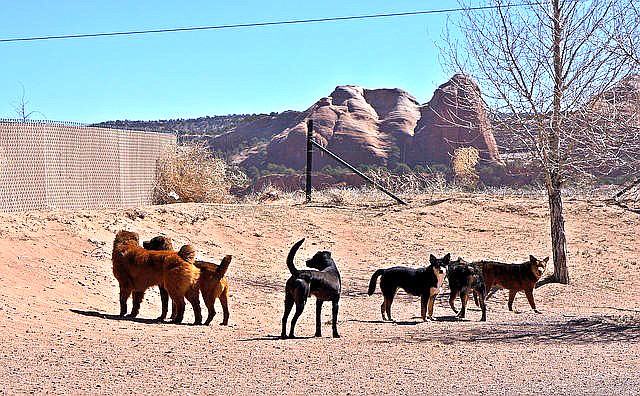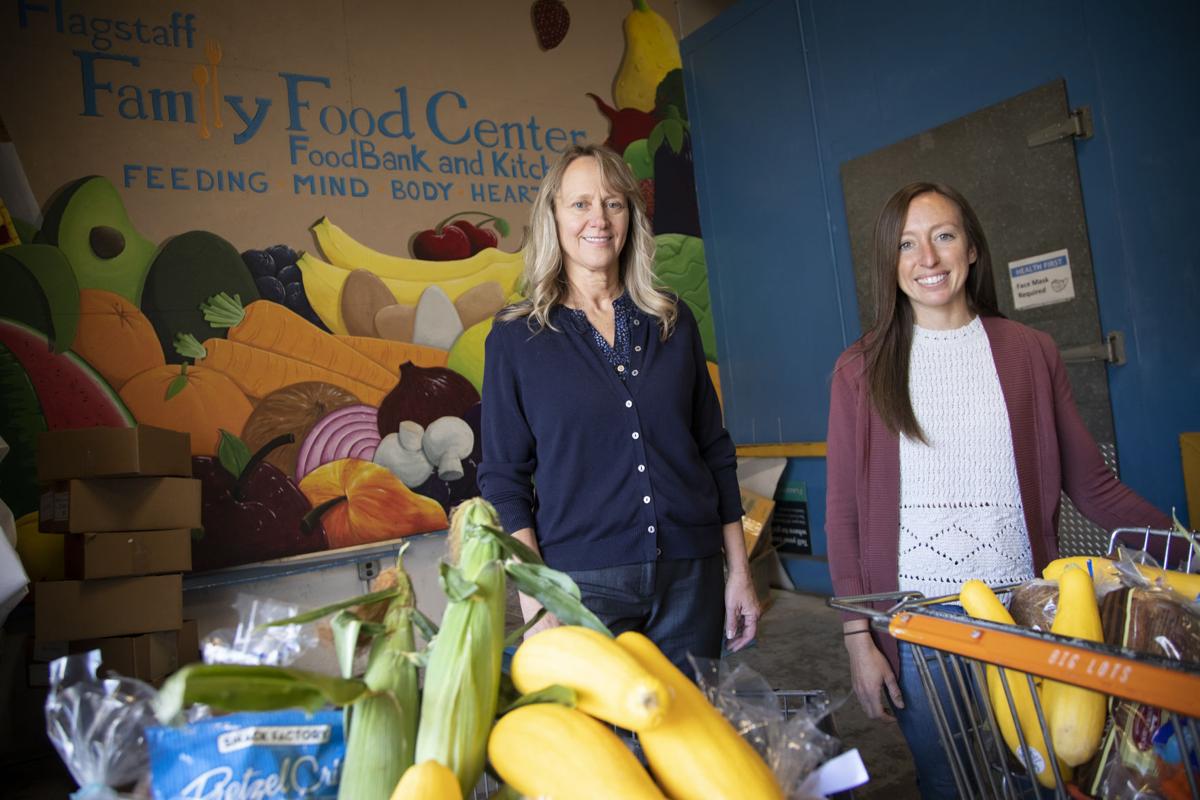Aggressive dogs, attacks a growing concern on Navajo Nation

TUBA CITY, Ariz. — In October 2019, a member of the Tuba City High School cross country team, was out for a run with his team during an afternoon practice, when he was attacked by a pack of dogs.
The attack was sudden and without provocation. With no help in sight, 15-year-old Ayden Beam, had no choice but to try to outrun the four dogs, as they barked, growled and nipped at his legs.
One dog was able to sink its teeth deep into Ayden’s inner-thigh, causing blood to instantly flow down his leg. But now, full of adrenaline, Ayden kept running as he knew that was his only chance of escaping the attack.
Ayden was able to make it back to the high school where he was treated and taken to the hospital. He received 13 stitches to close the gash on his inner thigh, and two additional stitches to close another cut on his outer thigh.
Ayden’s mother, Erica, said she reported the incident to the school along with local police department and animal control, but no action was taken.
The incident occurred just one week after a runner was bitten during the annual Bud David Invitations, a High School Track meet hosted by TCHS.
Around one year later, in 2020, another of Beam’s sons was bitten by a dog as he was entering the Tuba City Elementary School on his way to work.
“Luckily his (injury) weren’t nearly as bad as his brother’s but still (he) had to go to the emergency room during the height of COVID,” Beam said.
A common problem
Dog attacks and bites are nothing new in Tuba City or on the Navajo Nation.
According to Navajo Nation Animal Control, there are over 3,000 individuals treated each year at hospitals and clinics for animal attacks and bites.
“The majority of victims are children and elderly,” the agency stated.
Records from the Navajo Nation Office of Environmental Health show an average of 247 dog bites a year in Tuba City alone over the course of the last five years.
On a Nation with a geographical area the size of the state of West Virginia and a population of roughly 173,000 citizens, there are currently only five animal control officers and none are stationed in the Tuba City area.
Locally, Tuba City runners know all too well the dangers of hitting the pavement and roads to log in a few miles.
Just last year, Brittney Laughter, who works with the Tuba City Unified School District, had just finished her evening run and was walking along the street when a dog from across the street ran after her and sank its teeth into her calf. Laughter was able to get away from the dog, but from that day on she’s been scared of loose, unleased and even leashed dogs.
“I do my best to avoid them,” Laughter said. “Whether that might be taking a whole different route.”
But the danger of dog bites is not just a runner’s problem.
On May 26, Renelda Tsinnie’s daughter was walking their family dog on a leash along Peshlakai Avenue and Quartz Circle when a pack of six dogs attacked them. At first, they attacked the family dog, but as Tsinnie’s daughter tried to protect her dog, the pack turned on her, biting her hand.
“When the aggressive dog(s) start attacking, a few men driving south bound on Peshlakai stopped and assisted (my daughter) in breaking up the dog fight,” Renelda said. “The men were able to chase away the other dogs.”
Both Renelda’s daughter and one of the men who stopped to help were injured and treated at the hospital after the attack.
According to an article in the Navajo Times on May 16, Lyssa Rose Upshaw, 13, asked her mother, Marissa Jones, if she could go for a jog on a local trail near their home as her mother was preparing dinner. As the evening grew later, Jones began to worry as Lyssa hadn’t returned home yet.
Eventually Jones and other family members began searching the area. After searching the trail and with the help of Lyssa’s sister and cousin, Marissa’s worst nightmare came to pass. Lyssa’s body was found curled up in a fetal position, and pieces of flesh was scattered around.
“Her legs were all chewed up,” Jones recalled. “She was gone.”
The article notes that there were numerus aggressive dogs around the area that were barking and snapping at the family as they made their way toward Lyssa’s body.
Animal control officers were able to round up a total of 12 dogs involved in the attack, but Jones reported that the family had about 20 “mean dogs.” While this case is currently under investigation, there is no doubt in Jones’s mind that her daughter was killed by the pack of dogs.
The Navajo Times went on to report that “if Lyssa’s death is confirmed to be a result of predation, she will be the fifth person killed by dogs on the Navajo Nation since 2010.”
Victims include a 56-year-old man near Gallup in 2010, an eight-year-old boy in Pine Hill, New Mexico, in 2012, a three-year-old boy in Seba Dalkai, Arizona, in 2016, and a Kayenta woman last fall. Navajo Nation has…an estimated 250,000 free-ranging dogs.”
Finding a solution
On June 21, Navajo Nation President Jonathan Nez and Vice President Myron Lizer recommended changes to Navajo Nation laws to give more enforcement authority to animal control officers to deter dog attacks against people.
They also are seeking additional funding to better control the growing dog population by hiring more animal control officers, developing more animal shelters, increasing spay and neuter opportunities, increasing animal registrations and microchipping outreach efforts, and working with organizations to provide more adoption programs for unwanted animals.
While laws are being drafted to stiffen the penalties for owners unable to keep their dogs under control, two huge problems remain; the lack of Navajo Nation Animal Control Officers, and the fact that there are 250,000 dogs currently on the streets on the Navajo Nation, many of which are roaming freely.
Taking responsibility
While the Navajo Nation Council has vowed to make hiring more animal control officers a priority, along with increasing their budget, which would provide these officers with the resources and tools they need to adequately perform their job, a much bigger problem persists, and if not addressed, will only prolong the dire situation… owner responsibility.
Owners are not taking responsibility of their animals.
Navajo Nation Animal Control laws requires that owners can have a maximum of four dogs and four cats per house hold, and all dogs and cats must be licensed every year.
A dog or cat license requires that all immunizations, including rabies must be up-to-date, and both the license and rabies tag must be worn on the harness or collar of the pet at all times. Not abiding by these laws can subject the owner to a monetary fine.
Spaying or neutering your pet is extremely important toward controlling the pet population and ensuring the overall health of our dogs, cats, and community.
“Animal overpopulation and homelessness is a public safety and public health issue,” said Rose Moonwater with the Tuba City Humane Society. “Roaming packs of stray dogs keep community members from safely participating in regular exercise like walking, jogging, running and biking.”
Moonwater emphasizes the importance of getting your dogs spayed and neutered and noted that there are numerous options, including cost saving options toward getting your pet fixed.
“(I) know dogs are our protectors of ourselves, family and homes, but for them to attack, chase, interrogate outside their boundaries is unacceptable,” Laughter said. “As owners, it should be your responsibility to make sure the things like dog bites or chasing of people off your property doesn’t happen.”
Beam, whose two sons were bitten by dogs, said it is not the animals fault.
“I don’t blame the dogs but rather the humans that don’t take responsibility for their pet by neutering/spaying and keeping the dog on a leash, especially since they are territorial animals and only protecting them,” she said. “The Navajo Nation only has one animal control agency with a handful of agents and they are based out of Window Rock. Protect your community by controlling the dog population.”
Recently, Navajo Nation First Lady Phefelia Nez and Second Lady Dottie Lizer led a campaign to raise awareness about the importance of spaying and neutering pets to help control the animal population and reduce the number of unwanted animals on the Navajo Nation.
While dog attacks and bites have become a serious problem, the Navajo Nation is reacting and putting laws and resources in place to help the Nation, but ultimately this is a community problem. We must all do our part to help stop the overpopulation of dogs and cats in our own neighborhoods. Spay or neuter your pets, keep your dog on a leash or within a fenced area, and report any unwanted pets to the Tuba City Humane Society.
Groups Urge Permit Denial For Uranium Mine Near Grand Canyon’s South Rim
Conservation groups are urging Arizona regulators to deny a key permit for a uranium mine near the South Rim of the Grand Canyon. They say it threatens the area’s environment and tribal water resources. KNAU’s Ryan Heinsius reports.

The Pinyon Plain Mine, formerly known as the Canyon Mine, is located about seven miles from the South Rim of the Grand Canyon on the Kaibab National Forest. Conservation groups say it could contaminate area aquifers but the mine’s owner denies it’s a threat to local groudwater.CREDIT RYAN HEINSIUS / KNAUListenListening…1:10
In recent years water has continuously flowed from a shallow aquifer into the Pinyon Plain Mine, formerly known as the Canyon Mine. It’s then pumped to the surface and evaporated onsite. Environmental groups say the millions of gallons a year that enter the shaft contain high levels toxins. They worry deeper aquifers that feed springs in the Grand Canyon and serve as the Havasupai Tribe’s sole water source could be contaminated.
The Grand Canyon Trust and others are calling on the Arizona Department of Environmental Quality to deny the mine’s aquifer protection permit and permanently close it.
“The main risk is that when water is oxygenated and it comes into contact with uranium ore it will take up that uranium and other mineralized deposits like arsenic. And that will allow uranium that wouldn’t have otherwise traveled to travel,” says the Trust’s Energy Director Amber Reimondo.
The mine’s owner, Energy Fuels Resources, however, denies that it’s a threat to groundwater. A spokesperson says what does flow into the shaft is a relatively small amount and unconnected to larger, deeper aquifers. The mine is currently on standby and has yet to produce ore commercially. A public comment period is open through Aug. 7.
Flagstaff Family Food Center: 30 years of fighting hunger
- LARRY HENDRICKS Special to the Daily Sun

LARRY HENDRICKS Special to the Daily Sun
Bread, onions, watermelon, meat, milk, eggs and so much more fill rack after rack in the warehouse space on the east side of Flagstaff.
It’s all there, and available, for individuals and families in need, and for the last three decades, it’s the organization that has meant the difference between a full belly and an empty one in the lives of thousands.
This year, the Flagstaff Family Food Center, Food Bank and Kitchen marks 30 years of serving the community.
Monica Foos, executive director, said, “For 30 years, the Flagstaff Family Food Center has relied on volunteers and supporters like you to keep our doors open 365 days a year for anyone in need, even during forest fires and a global pandemic. It was only with the support of the Flagstaff community that we were able to help thousands of families this past year, providing over 5 million meals to those in need in 2020.”
Five million meals in one year — that’s a long way from the humble beginnings of opening a food center in the old Christmas Tree Restaurant at 1903 N. Second St., in Sunnyside, in 1991. What started out as an effort to serve a nutritious meal to the most insecure of residents has grown.
Now, with an annual budget of about $1 million, the FFFC not only serves hot meals, it also has a backdoor lunch program, a food box program, a food rescue program, a food for farms program, offers deliveries to anyone in need, gives non-profit agency food support, supplies mobile pantries across the community and even has a children’s literacy program. There are a total of 12 programs, and about 60 percent of the FFFC income comes from individual donations from the community.
For most of the organization’s life, its mission was to serve hot meals daily. But, in 2013, on news that the St. Mary’s Food Bank Alliance would close its Flagstaff plant, the FFFC board voted to acquire the struggling Northern Arizona Food Bank. From there, it took over local food rescue and food box distribution for St. Mary’s.
The organization continues to rely heavily on volunteers, said Carrie Henderson, development director at FFFC. It takes about 50 volunteers every day — at both locations and out in the community — to keep the operation running. Volunteers are always needed.
Food is received from St. Mary’s, deliveries from other food banks in the network, community food drives, and food rescues from local markets and restaurants. Volunteers help sort, box, distribute, cook, prepare the food for all of the organization’s programs. Waste is minimized. All food that doesn’t get used or traded to another food bank is fed to animals at local farms.
The COVID-19 pandemic proved challenging, with many families needing help they didn’t previously need, Henderson said.
“So many families were already living paycheck to paycheck before the pandemic, and after having their income disrupted during COVID, it will take them several months to get back on their feet,” Henderson said. “We saw an outpouring of support from the community in 2020, but we continue to need financial support as families rebuild after the pandemic.”
The goal is to continue delivering about 100,000 pounds of food a week and serving about 2,000 people a day, Henderson said.
“The community, for the last 30 years, has allowed us to keep our doors open 365 days a year to help feed people,” Henderson said. “Thank you.”
The work is never done, Foos said.
“We still need your help to make sure that no child, senior, or individual in our community goes without food this year,” she said. “We know there are still hundreds of people in need who we are not yet reaching. With your support, we can expand our Mobile Distribution program to new locations in 2021, including senior centers, rural communities, and underserved locations throughout Flagstaff.”
To volunteer, to donate or to learn more about the Flagstaff Family Food Center, visit www.hotfood.org, or call (928) 526-2211.



